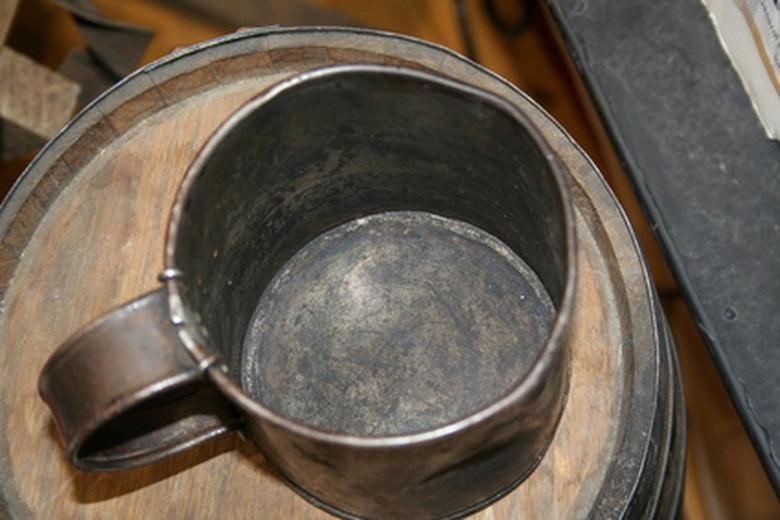Cleaning Tarnished Tin At Home
Tin is a soft, white metal processed from cassiterite, a mineral. It doesn't contain iron, so it doesn't rust, but when it oxidizes, it results in black tarnish on the areas exposed to the air. Because tin is soft, it is often mixed with stronger metals or used to coat steel to prevent rust. Cleaning tarnish off tin items generally requires a light hand and a little scrubbing to bring it back to a soft, gleaming surface.
About Tin Foil
Tin is not the same metal as aluminum; they are two different elements. The atomic number for tin is 50, while aluminum is 13. The two metals have different properties and uses, ranging from home décor to cookware to manufacturing.
Some of the confusion between aluminum and tin is due to the metallic foil used in your kitchen. Foil was originally tin and was used to package a wide range of products, but it added a "tinny" or bitter flavor to food. Aluminum foil was cheaper, lighter, and more durable, making it easier to mass produce and market. Despite the change of materials, many cooks and their families still call it "tin foil."
In general, tin is not just stiffer than aluminum but also resistant to corrosion and oxidation. Despite its resistance, tin objects and collectibles can still get dirty and tarnish.
Cleaning Tarnished Tin
Lightly tarnished decorative tin items and jewelry are best cleaned with soap and water. If dishwashing liquid and water isn't enough, try a light sprinkle of powdered cleanser, like Bar Keepers Friend; a paste of 2 tablespoons of baking soda mixed into 1 cup of water; or a bit of plain, white toothpaste. Use a wet sponge, scrubber, or soft toothbrush to gently scrub the dirt and tarnish off the item. Rinse well and allow it to air-dry. Then buff it with a soft cloth.
While some sources recommend using acidic solutions for soaking and cleaning tin, these substances can etch and damage tin collectibles, jewelry, backsplashes, and other items. Generally, a good cleaning with dishwashing liquid and water and a plastic scrubber will resolve the issue.
Tin-lined copper cookware may be tarnished due to long use and improper cleaning. Burnt-on food is an issue, as the melting point of tin is 449 degrees Fahrenheit, much lower than copper, stainless steel, and cast iron. To remove oxidation and cooking crud:
- Fill the pan with water.
- Add dishwashing liquid and bring it to a low, rolling boil for 10 minutes.
- Pour out the water and soap solution.
- Rinse and allow it to air dry.
Another method of cleaning heavily oxidized tin-lined copper cookware is to:
- Fill the pot with water.
- Put a piece of folded aluminum foil in the water.
- Weigh down the foil with a small, heat-resistant glass or ceramic bowl.
- Add 1 teaspoon each of baking soda and noniodized table salt for each quart of water in the pot.
- Bring it to a low boil.
- Boil for five minutes and watch the foil turn black as it pulls the tarnish off the tin lining.
- Remove it from heat and allow it to sit for up to 15 minutes.
- Pour the hot water and foil into the sink.
- Wash the pot with dishwashing liquid and hot water.
- Rinse well and allow it to dry.
If necessary, an extra scrub with a little more dishwashing liquid and a plastic or nylon scrubber should remove any lingering tarnish. Avoid using metal scouring pads, as they will scratch and damage the soft tin surface.
Removing Corrosion on Tinware
Tinware is made of metal covered with a thin layer of tin. These items are often decorative painted items, like signs, biscuit tins, and other items. While tin doesn't rust, if the surface is damaged and the underlying metal is exposed to air, rust spots may appear on the painted surface. To remove the rust:
- Dampen a cotton swab with mineral spirits.
- Roll the barely damp swab over the rusted area.
- Check the painted tin surface for damage.
- Rub and roll gently to remove the rust from the paint.
- Allow it to dry completely before storing the piece.
If the tinware is a family heirloom or a valuable piece, consult with a professional conservator. When in doubt, don't try to clean the item. You may permanently damage the paint and reduce its value.
